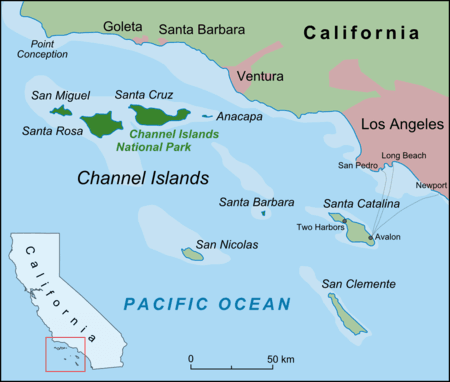California Diving and the Channel Islands
Diving California and the Channel Islands and can be a unique and memorable experience. California diving is so diverse. You can cruise through a beautiful kelp forest and dive shipwrecks and plane wrecks with an interesting history. Maybe catch your limit of lobster, spear that big halibut, or go diving at one of the oil rigs. With the many miles of California coastline, you can also shore dive from mellow to extraordinary. Either way, it’s all fun and there is something for everyone.
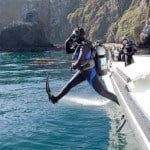 California scuba diving is more diverse and colorful than most would think. With its marine life, rocky reefs, pinnacles, walls, sandy plains, wrecks, and the Channel Islands there is much to see. For the diver, there are many opportunities. Truly there is something for everyone anytime of the year. There is good beach diving along much of the coast and some great boat dives leaving from a number of harbors, mainly going to the Channel Islands and sometimes to outstanding local offshore dive sites.
California scuba diving is more diverse and colorful than most would think. With its marine life, rocky reefs, pinnacles, walls, sandy plains, wrecks, and the Channel Islands there is much to see. For the diver, there are many opportunities. Truly there is something for everyone anytime of the year. There is good beach diving along much of the coast and some great boat dives leaving from a number of harbors, mainly going to the Channel Islands and sometimes to outstanding local offshore dive sites.
Diving the Channel Islands
 The Channel Islands are like a diver’s playground. Altogether, the Channel Islands span a distance of 160 miles from Point Conception to San Diego and lie between 11 and 60 miles offshore.
The Channel Islands are like a diver’s playground. Altogether, the Channel Islands span a distance of 160 miles from Point Conception to San Diego and lie between 11 and 60 miles offshore.
They comprise two distinct groups: four Northern Islands (San Miguel, Santa Rosa, Santa Cruz, and Anacapa) and four Southern Islands (Santa Barbara, Santa Catalina, San Nicholas, and San Clemente). All four of the Northern islands and Santa Barbara Island from the Southern group belong to the Channel Islands National Park, while San Clemente and San Nicholas Islands are owned by the military. Santa Catalina Island is mostly owned by the Catalina Island Conservancy with the remainder falling under the jurisdiction of Los Angeles County.
California Coastal Diving
 Diving the California coast can be just as rewarding as a good boat dive at one of the Channel Islands and sometimes even better. Like anything, it is all about location and timing. Some people wonder why dive the coast when the islands have great diving and that is because lots of divers just seem to get stuck in the same old rut and never really venture out to see and do something different. Over the years Ken the owner of Channel Islands Dive Adventures has done many shore dives from northern Los Angeles County to Monterey. Some were easy and some probably will not ever be done again. It is all a learning process.
Diving the California coast can be just as rewarding as a good boat dive at one of the Channel Islands and sometimes even better. Like anything, it is all about location and timing. Some people wonder why dive the coast when the islands have great diving and that is because lots of divers just seem to get stuck in the same old rut and never really venture out to see and do something different. Over the years Ken the owner of Channel Islands Dive Adventures has done many shore dives from northern Los Angeles County to Monterey. Some were easy and some probably will not ever be done again. It is all a learning process.
From all the exploration over the years Ken’s MOST favorite areas are the offshore deeper reefs south of Ventura at the Deep Hole area and the Central Coast between Avila Jade Cove and Big Sur. The reason for this is access, beauty, and just how spectacular these areas are. Access can be difficult but if you can manage it the sites are beautiful especially because most get very few divers.
To help out we have some excellent info for Coastal Dive Sites-Ventura to Malibu and Coastal Dive Sites-Avila (Port San Luis) to Big Sur with us finishing up info on our Big Sur to Monterey info.
Wrecks of the Channel Islands
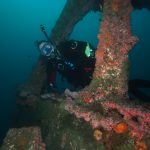 California is not what would be considered a great wreck diving destination. This is due to many of the wrecks being broken up from years of ocean and weather conditions and a number of them just aren’t very accessible but what they do offer is history. Many are within the National Park, State, or Vandenberg Military base boundaries and it is, look and take pictures only. For the Honda wrecks in front of Vandenberg, they are now closed to the public indefinitely which happened just after Sept. 11, 2001.
California is not what would be considered a great wreck diving destination. This is due to many of the wrecks being broken up from years of ocean and weather conditions and a number of them just aren’t very accessible but what they do offer is history. Many are within the National Park, State, or Vandenberg Military base boundaries and it is, look and take pictures only. For the Honda wrecks in front of Vandenberg, they are now closed to the public indefinitely which happened just after Sept. 11, 2001.
All the wrecks we have listed in our resource section are within recreational diving depths although some are very hard to get to. There are a number of deeper wrecks plus others down south out of San Diego that we don’t have listed but with some good searching you can always find out more info about them.
Because the Channel Islands are very diverse and large we have made two separate pages covering the wrecks. They are the Southern Channel Islands and the Northern Channel Islands. We have tried to cover as much of the history and details of each wreck that we could. Some of the wreck diving sites you will find on maps and others you won’t. Over the years, Ken the owner of Channel Islands Dive Adventures has dived most all these wrecks.
Marine Protected Areas
In California, we have Marine Protected Areas, Marine Reserves, and National Marine Sanctuaries and each one is set-up for a specific reason with several management objectives for its specific area. You can read about each and how they impact divers at this page-Marine Protected Areas.
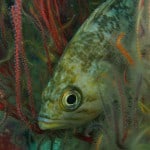 Marine Protected Areas are set up to conserve, manage, and protect ecosystems, preserve cultural resources such as shipwrecks and archaeological sites, or sustain fisheries production. They are established and managed by all levels of government.
Marine Protected Areas are set up to conserve, manage, and protect ecosystems, preserve cultural resources such as shipwrecks and archaeological sites, or sustain fisheries production. They are established and managed by all levels of government.
A Marine Reserve usually connotes ‘maximum protection’, where all removals of resources are strictly prohibited. Marine Parks lay a high emphasis on the protection of ecosystems but have been known to allow light human use. A Marine Park may prohibit fishing or extraction of resources of any kind, but could possibly allow recreation. Some are established to protect historical sites such as shipwrecks and cultural sites or to protect a certain species. Others are to benefit fisheries, rare habitat, as nursing grounds for fish, or to protect entire ecosystems.
National Marine Sanctuaries are federally protected waters. These waters include habitats such as rocky reefs, kelp forests, deep-sea canyons, and underwater archaeological sites. Similar to national parks on the land, these underwater preserves provide a safe habitat for species close to extinction or protect historically significant shipwrecks.
Diving the Oil Rigs
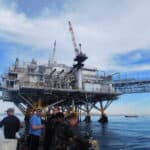 Oil platforms (oil rigs) are busy, privately owned workstations. Some are decommissioned, but most are still in active operation. Some of these rigs are in deep water; their support structures rising from depths of 700 feet or more. The oil rig pillars and cross beams act as an open water oasis. making a home for reef & wall critters, and a resting/feeding stop for open ocean species making excellent artificial reefs!
Oil platforms (oil rigs) are busy, privately owned workstations. Some are decommissioned, but most are still in active operation. Some of these rigs are in deep water; their support structures rising from depths of 700 feet or more. The oil rig pillars and cross beams act as an open water oasis. making a home for reef & wall critters, and a resting/feeding stop for open ocean species making excellent artificial reefs!
There are plenty of offshore oil rigs along the coast of California and of all the platforms the only ones that can be dived recreational are Eureka, Elly, and Ellen. The three sit in federal waters 8 ½ miles offshore from the Los Angeles area. Eureka is the deepest rig accessible to divers with it sitting in 720’. Elly and Ellen are unusual because they are a double platform with a bridge connecting them together sitting in about 260’ of water.
There are many opportunities to dive the oil rigs and they are an advanced dive. The boats cannot anchor so there are plenty of safety concerns and procedures so when everyone does their part you can have some of the best dives offered in California. Read all about the rigs and how to dive them on this page-Oil Rig Diving.
When to dive California and the Channel Islands
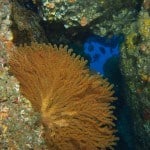 The weather conditions in Southern California and the Channel Islands are usually mild but can change quickly anytime. The best diving conditions generally are during the fall and winter. Divers are lucky to have the islands close because on most days there is somewhere to get a good day of diving in. Water temperature and visibility also vary throughout the year. The warmer water and greater visibility usually are in the Southern islands such as Catalina and San Clemente Islands. Because of the deepwater upwelling at Point Conception, the Northern islands like San Miguel have the coldest water temperatures.
The weather conditions in Southern California and the Channel Islands are usually mild but can change quickly anytime. The best diving conditions generally are during the fall and winter. Divers are lucky to have the islands close because on most days there is somewhere to get a good day of diving in. Water temperature and visibility also vary throughout the year. The warmer water and greater visibility usually are in the Southern islands such as Catalina and San Clemente Islands. Because of the deepwater upwelling at Point Conception, the Northern islands like San Miguel have the coldest water temperatures.
During the fall between September and November is typically when the east winds (Santa Ana’s) blow. This brings warm dry air offshore from the desert to the ocean. Because of this, it pushes the top layer of water out away from the shore, allowing the ocean upwelling’s to bring the cleaner colder water in. This makes for great diving conditions. On a good day, the diving conditions can rival any warm water location. Of course without the warm water. Water temperatures vary between the islands with fall generally having the warmest water and best visibility.
 Wintertime is December through March. December and January usually having some spectacular diving days before the storms come through. February and March are the stormy rainy months. When the storms come they bring large swells and surf that stir up the water and cause the visibility to drop dramatically both at the islands and beaches.
Wintertime is December through March. December and January usually having some spectacular diving days before the storms come through. February and March are the stormy rainy months. When the storms come they bring large swells and surf that stir up the water and cause the visibility to drop dramatically both at the islands and beaches.
April and May are springtimes. This brings a renewed freshness that shows with all the plants and flowers blooming around the Channel Islands. The islands are beautiful at this time of year, although the diving conditions are less than stellar. The visibility is reduced and the water temperatures are usually at their lowest.
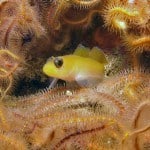 Summer is when most divers like to go diving. On the contrary, summer is when the conditions are not at their prime for diving. During June through August, the water temperature starts to warm up. At the same time, it lets the plankton bloom which creates days with some not so good visibility. The main thing about the summer is after a day of diving, you have the hot sun to look forward to warm you up.
Summer is when most divers like to go diving. On the contrary, summer is when the conditions are not at their prime for diving. During June through August, the water temperature starts to warm up. At the same time, it lets the plankton bloom which creates days with some not so good visibility. The main thing about the summer is after a day of diving, you have the hot sun to look forward to warm you up.
Where does Channel Islands Dive Adventures fit into all this
There are many more places to dive than just around the islands. There are wrecks at some of the islands and offshore from the coast. There are Oil Rigs in the channel between Long Beach and Catalina. There are awesome offshore reefs along the coast and so much more for the person looking for something different. This is where Channel Islands Dive Adventures fits in. We focus on single and multi-day trips to unique spots around the Channel Islands and coastal areas.
